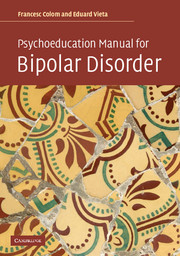Book contents
- Frontmatter
- Contents
- Foreword
- Preface
- Part 1 Clinical, diagnostic, and therapeutic aspects of bipolar disorders
- Part 2 Concept and methodology of psychoeducation
- Psychological treatment and bipolar disorders: why psychoeducate?
- Mechanisms of action of psychoeducation
- Integrating psychoeducation in clinical practice
- When to introduce psychoeducation?
- Formal aspects of the psychoeducation program
- Part 3 Psychoeducation program: sessions and contents
- Bibliography
- Index
Integrating psychoeducation in clinical practice
from Part 2 - Concept and methodology of psychoeducation
Published online by Cambridge University Press: 06 January 2010
- Frontmatter
- Contents
- Foreword
- Preface
- Part 1 Clinical, diagnostic, and therapeutic aspects of bipolar disorders
- Part 2 Concept and methodology of psychoeducation
- Psychological treatment and bipolar disorders: why psychoeducate?
- Mechanisms of action of psychoeducation
- Integrating psychoeducation in clinical practice
- When to introduce psychoeducation?
- Formal aspects of the psychoeducation program
- Part 3 Psychoeducation program: sessions and contents
- Bibliography
- Index
Summary
One of the greatest problems of evidence-based medicine is the distance that often separates tested approaches and suitable approaches. Most clinical trials of a drug can be criticized because they suffer from a certain sample bias (only cooperating patients are included, the frequency of visits is increased, etc.), a bias that is used as an argument against the possibility of generalizing the results of studies. However, although the legitimacy of such criticisms must be recognized, randomized clinical trials are certainly the only method of demonstrating the efficacy of a specific treatment. In real world practice, open series and naturalistic studies can be very useful in determining the applicability and efficiency of a treatment, but not its efficacy, since by definition its methodology is less rigorous. In spite of that, a hierarchically arranged combination of these two strategies is the only way to provide an overall evaluation of the clinical usefulness of any treatment: first the randomized-controlled study is performed, and then, if the results are positive, the open series.
Curiously, the path followed in the field of psychoeducation in bipolar disorders has been exactly the reverse: during the 1970s, 1980s and beginning of the 1990s there were numerous open series articles, hindered by several methodological pitfalls, intended to determine the applicability of a specific program. It was not until the end of the 1990s and the beginning of this century that the first controlled studies on efficacy appeared (Perry et al., 1999; Colom et al., 2003a, b).
- Type
- Chapter
- Information
- Psychoeducation Manual for Bipolar Disorder , pp. 34 - 39Publisher: Cambridge University PressPrint publication year: 2006

